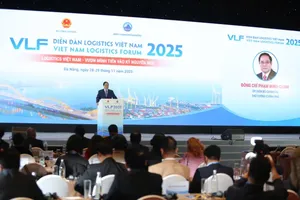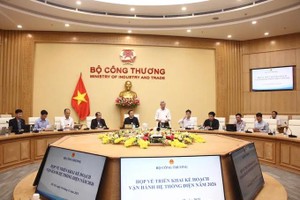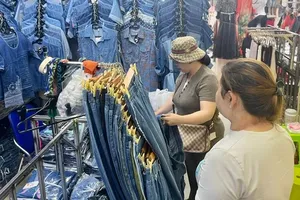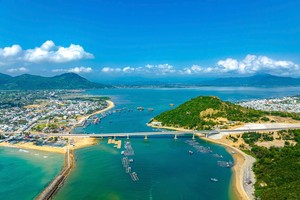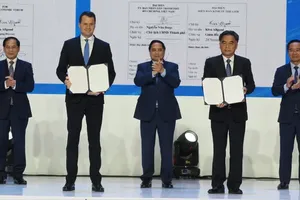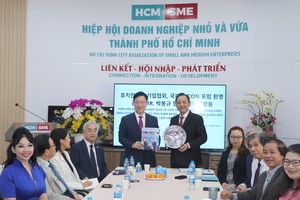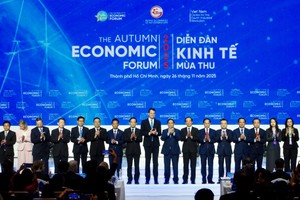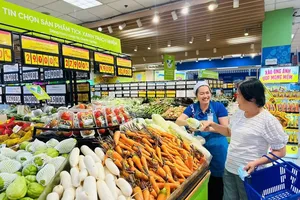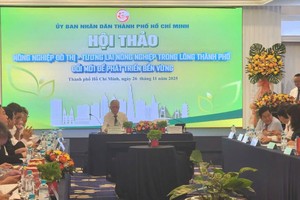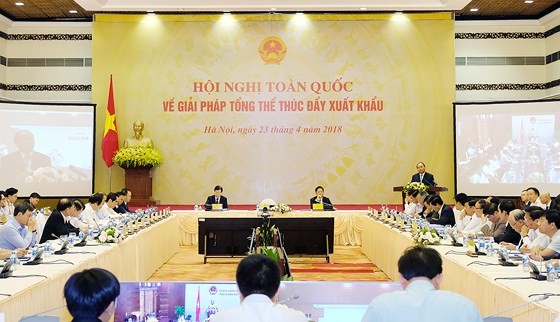
On April 23, Prime Minister Nguyen Xuan Phuc chaired an online conference on comprehensive measures to boost exports in 2018 with the participation of the ministries, localities, associations, and export enterprises.
2017 export activities achieved some positive results, reported by the Minister of Industry and Trade Tran Tuan Anh. Export scale enlarged sharply, surpassing US$200 billion for the first time. Export volume increased 2.21 times higher than 2011 (US$96.9 billion), the commencement of imposing the import-export strategy in the 2011-2020 period, toward 2030.
Average export growth rate reached 12 percent per year. GDP growth rate gained a good result, improving the balance of payments, stabilizing the macroeconomic, creating spillover effects, increasing production, and creating jobs and income for millions of workers.
The structure of export products successfully transformed, said the Minister. The processing industry in 2017 accounted for 81.3 percent, far higher than 61 percent in 2011. The proportion of agricultural and aquatic products decreased to 12.1 percent (20.4% in 2011). The figure for fuel and minerals made up only about 2 percent (11.6% in 2011).
The processing industry continued to be the main driver of export growth, with many items achieving impressive growth rates such as telephones and telephone components (US$45.27 billion, up 31.9% ); computers, electronic products, and electric components (US$25.9 billion, up 36.8%).
Localization rate in export products gradually improved. While that in the garment and textile sector represented about 15-17 percent in 2000, the figure was over 50 percent in 2017.
The textile and garment sector actively managed domestic resources and exported raw materials (the turnover of exported fibers, yarns, and textiles increasing to 22.7%)
Eight agricultural and aquatic products joined the group of over VND1 billion export value including seafood (US$8.32 billion, up 18%), fruits and vegetables (US$3.5 billion, up 42.5%), and cashew (US$3.52%, up 23.8%).
The export market development has achieved positive results. Vietnam continuously exploited the traditional markets and expanded into the new ones. 2017 reported 28 markets with the turnover of more than US$1 billion, of which 7 reached over US$5 billion and 4 got over US$10 billion.
Taking advantage of integration commitments was effective, Tran Tuan Anh added. All markets which signed the Free Trade Agreement (FTA) with Vietnam witnessed the remarkable growth rate such as Korea (up 31.1%), ASEAN (up 24.3 %) and Japan (up 14.2%). Besides, export to some large markets remained stable (the US, EU) or increased phenomenally (China, up 60.6%).
2018 sees opportunities for export growth with the positive forecasts of world demand recovery. The partners continue to deduct or abolish import tariffs under the FTA commitments that add competitive advantages for Vietnamese goods. The Comprehensive Partnership and Trans-Pacific Partnership (CPTPP) and the Vietnam-EU FTA expected to come into effect in 2019 have attracted more foreign direct investment to expand Vietnam's production capacity.
Furthermore, the export activities have also benefited from the joint efforts of the Government and ministries in reforming administrative procedures and creating favorable, open, and transparent business and investment environment that smooth the way of domestic production.
However, Vietnam's export activities face many difficulties and challenges. Despite the flourishing forecasts, the 2018 global trade poses imminences due to the recent tension in diplomatic and economic relations among major economies. The re-emergence of Protectionism which becomes apparent in the first few months of 2018 and the adoption of stricter food safety and environmental protection standards by importing countries are among the biggest difficulties for Vietnam.
PM Nguyen Xuan Phuc requested the highlighted subjects for discussion including export difficulties and barriers and recommendations to promote exports.
He appreciated the export volume of over US$ 200 billion for the first time ever and many products with the turnover exceeding US$ 1 billion, particularly manufacturing industry and agriculture.
The potential for export is great, the PM added. Vietnam has negotiated 12 trade agreements and been working on the others to fully open and integrate in the world. Many provinces have been enhancing their export promotion strategies. A lot of efforts have gone into finding new markets. Even senior leaders have participated in negotiating, promoting trade, and finding markets for exports.
The PM also commented on some advancements of administrative reforms such as customs procedures, port services, and quarantine regulations. However, there are a number of difficulties and barriers in export, for example, the matter of global export trade due to tensions in many regions, the risk of a trade war, the re-emergence of Protectionism, and the adoption of stricter regulations on importing agricultural products.
Therefore, diversifying export products and markets and strictly controlling goods quality are among recommendations. Speeding up production without managing "input" and goods quality hinders from exporting. Besides, other obstacles include the tenuous link between production and market and the quality of products degrading which undermine the brand image of Vietnam.
The PM raised five important questions of how to increase the added value of export goods and products, how enterprises can access to export market information and risks, how the ministries implement the strategy for exporting and developing market, and what initiatives enterprises propose to remove export barriers in particular.
The PM urged enterprises to present obstacle issues related to regulations in export activities. Writing to the PM was offered if enterprises could not deliver a statement at the conference. A PM's Directive on import-export enhancement and export barriers removal would be issued, he affirmed.

